Cogitator 091028
Where's Waldo....he's with President Bob, looking for the meeting. Ed Neff winged his way through opening ceremonies as we waited for our leader to arrive. Fortunately the initial part of the meeting is lunch, which most members were able to figure out for themselves.
No anniversaries on the calendar, but Mike Gemma has a birthday on the 30th..at which time he will be 30
NO MEETING NOVEMBER 11...NO MEETING NOVEMBER 11TH
HOWEVER...THERE IS A BOARD MEETING ON NOVEMBER 12TH---7:30 AM...METHODIST CHURCH ON ROUTE 2.
Mike Balsamo reports $5,500 in Citrus Sales so far...with the campaign in full swing. Paula Buckheit says the Interact students will help us push sales during the Veterans Day Parade on the 11th. If you can help, let her know.
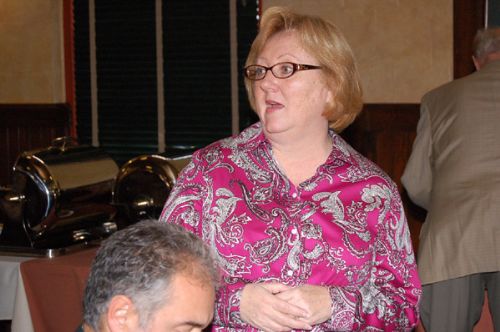
The Phone Books are here..the phone books are here. The book has been mailed out and all is right with the world. To date no one has called to complain about being left out or listed incorrectly. However there is still time.
See John Wolcott if interested in the Foundation Dinner. We have a group that will be attending.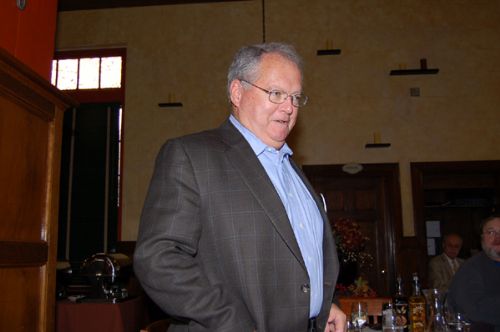
Bob Sloan is back following a three week trip to China. We went, Bob said, because we just love Chinese food, and it's easily available there. They had ordered in advance of their trip, and it was delivered to their room every night.
Alan Flynn has more time for Rotary. He is now a resident of North Kingstown, ending a weekly 45 minute commute from Rehoboth. The trip now takes 15 minutes each way, giving him an additional hour a week to be a Rotarian.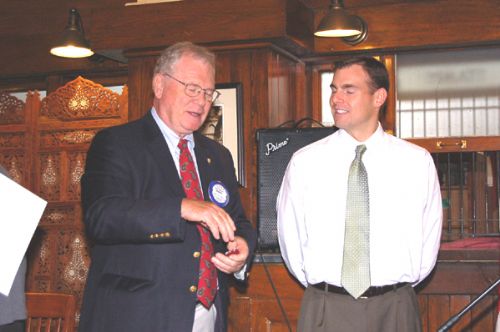
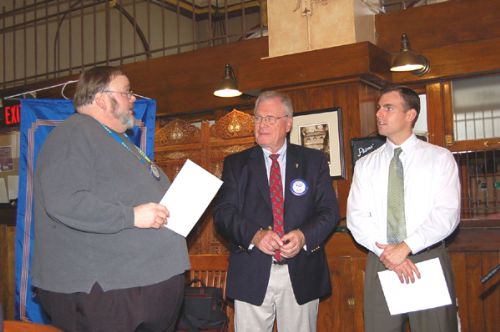
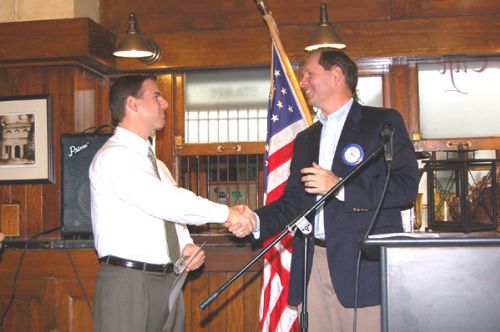
He's official. Damon Palagi is now one of us. After weeks of scrutiny, a fireside chat, a check of his income taxes for the last 12 years and a letter of recommendation from the FBI, Damon has been inducted into the club. Damon has been assigned to the ALS race and thee are indications he may challenge Vin Meola on the course. Vin has held the record as the oldest living Rotarian actually running in the race, and placing.
Bob Miller reported from the first ALS organizational meeting that Chairperson Judy Pratt is full speed ahead for the coming event, which will be the 10th annual running. Over the 9 years of the race it has generated just under a quarter of a million dollars to help victims of ALS.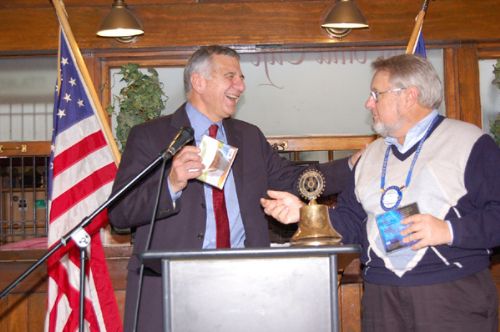
Guest speaker Lou Giancola, adminstrator of South County Hospital, gave an update on the hospital and the status of the Rhode Island Health Care delivery system today.
The Following is from the Blue Cross Blue Shield Publication "Today's Healthcare Costs".
TIME MAY BE RIGHT FOR PATIENT-CENTER MEDICAL HOMES.
The patient-center medical home (PCMH), an "enhanced" primary cre model, can serve as "a foundation for transformation of the U.S. Healthcare system if it is appropriately conceived and properly implemented", according to a recent study by the IBM Institue for Business Value.
"Replacing poorly coordinted acute-focused, epilsodic care with coordinated, proactive, preventive, acute, chronic, long-term, and end of life care is foundational to the transformation of the U.S. healthcare system," the IBM study maintained.
The IBM report cites several factors tht work together to drive up healthcare costs, limit access to care and healthcare quality, and "challenge" the systems status quo. They are:
Globalization
Consumerism
Changing demographics and lifestyles
Diseases, many of them chronic, that are expensive to treat
Proliferation of medical technology and treatments
As a result, IBM reported, the current system is "geared to treating and rewarding acute, episodic interventions. the emphasis is on reactive care, not on prevention and wellness condition." Given this situation, the IBM report declared, " We bvelieve the US Healthcare system is broke and unsustainable. Primary care, a critical piece of any healthcare system, is the most broken.
Cand the PCMH play a pivotal role in transforming the US healthcare system? Though there are no guarantees, the IBM study believes it has that potential. They advocate for replacing poorly coordinated, acute-focused episodic care that focuses on fees for services performed with coordinated proactive, preventive acute, chronic, long-term and end-of-life care, that rewards positive outcomes.
The PCMH concerpt has already entered the national healthcare reform dialogue. For those not familiar with it, the PCMH provides patient care that is accessible, continuous, comprehensive and coordinated in the contex of family and community, according to the American Academy of Pediatrics. The idea is not entirely new, having begun in some places as early as 1967. The core of the PCMH concept is the patients personal, comprehensive, long-term relationship with the primary care physican (PCP). In a PCMH a patient's care is headed by a PCP who is supported by a team of professionals. This team may include nurses, nurse practitioners, patient educators, pharmacists and other caregivers. But it is the patient who is central to the healthcare experience. Quality and safety are hallmarks of the medical home, the IBM study maintains.
Rather than being just a resource for episodic care, the PCP-led care team assumes proacstive prevention, wellness and chronic illness care, bvecoming the patient's confidant, coordintor and aviser for all aspects of healthcare, the study stated.
While most conversastions about the PCMH concept focus primarily on its potential ability to improve access and quality of care, the concept is also believed to have the potential to rein in healthcare costs.
In a report earlier this year, the American College of Physicans stated that "the preventive care that primary care physicans provide can help to reduce hospitalization rates. In 2000 an estimated five million admissions to US hospitals, with a resulting cost of more than $26.5 billion, may have been preventeable with high-quality primary and preventive care treatment. Assuming an average cost of $5,300 per hospital admission, a 5% decrease in the rate of potentially avoidable hospsitalizations alone could reduce inpatient costs by more than $1.3 billion.
In addition, the ACP found that, at the state level, an increase of one primary care physician per 10,000 population in a state was associated with a rise in that state's quality rank by more than 10 places and reduction in overall spending of $684 per Medicare beneficiary.
The IBM study reported that patients who have a PCP will incur about a third less healthcare expenditures and will have 19 percent lower mortaility. They are 7 percent more likely to stop smoking and 12 percent less likely to be obese.
Around the country, 44 sttes, Rhode Island included, are now conducting or have already conducted pilot PCMH programs. Pilots have demonstsrated success in key areas such as improved quality, greater patient compliance and more effective use of healthcare services, such as reductions ini unnecessary of avoidable hospitalizations and use of emergency rooms for primary care, the IBM study noted. A PCMH pilot in Detroit for example, proved successful both medically and financially, IBM reported, with a significan reduction in emergency department us. In North Carolina, a pilot tageting that state's under-insured and uninsured population had an asthma program that reduced hospital admission rates by 40 percent and a diabetes program that imrpoved quality of care by 15%.
Rhode Island's program, known as the Rhode Island Chronic Care Sustainability Initiative (CSI-RI), is a two year pilot program that egan in October 2008. the office of the Helath Insurance Commissioner is spearheading the program. Blue Cross & Blue Shield of Rhkode Island is a major partner in the pilot.
While the IBM report found tht the PCMH conceplt holds great promise for impr9oving the nation'ss healthcare system, it also included cautionary language. While medical homes can be a cornerstone of transformastion, they are not a sliver bullet. they hold a great deal of promise, but many more supportive measures need to be underetaken to fully realize the bienfits. For example, the report cites improved access to patient information and clinical knowledge as necessary to improve prevention, diagnosis and treatment. Financial changes--including revised reimbursement strategies for PCPs and others associated with PCMHs -- will also be needed.
Status quo is not an option, so stakeholdes should actiely participate in collaboratively shaping a more affordable , sustainasble, high-valued healthcare system, IBM concluded.
Today's Helthcare Costs..September 29, 2009
A publication of Blue Cross Blue Shield of RI
.png)
